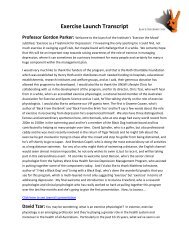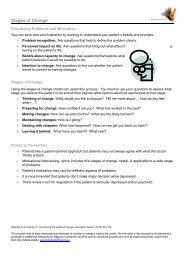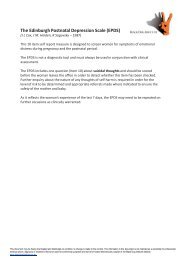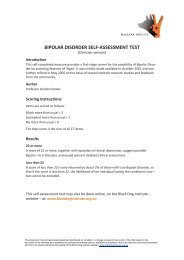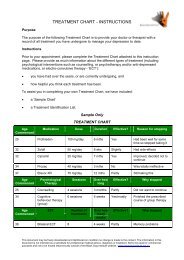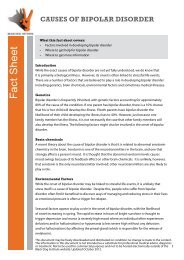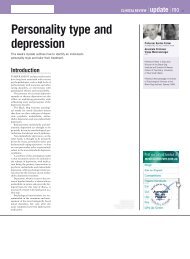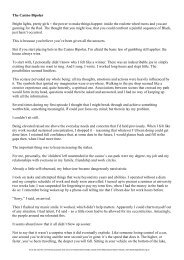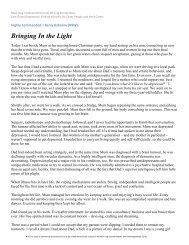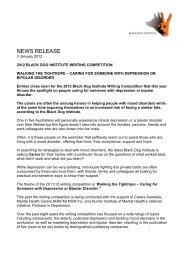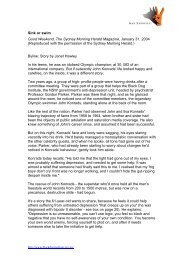Download a PDF of the 2012 Annual Report - Black Dog Institute
Download a PDF of the 2012 Annual Report - Black Dog Institute
Download a PDF of the 2012 Annual Report - Black Dog Institute
You also want an ePaper? Increase the reach of your titles
YUMPU automatically turns print PDFs into web optimized ePapers that Google loves.
The <strong>Black</strong><strong>Dog</strong> <strong>Institute</strong>InternationalLecturesThe Uses and Misuses <strong>of</strong> Psychiatric Diagnosis – Pr<strong>of</strong>essor Allen Frances MDPr<strong>of</strong>essor Allen Frances, prior Chair <strong>of</strong> <strong>the</strong>DSM-IV Task Force and Pr<strong>of</strong>essor Emeritus, DukeUniversity, cogently presented his views on <strong>the</strong> problems<strong>of</strong> <strong>the</strong> latest update <strong>of</strong> <strong>the</strong> DSM (Diagnostic andStatistical Manual <strong>of</strong> Mental Disorders), DSM 5, and<strong>the</strong> very real concerns evidenced by fellow pr<strong>of</strong>essionalsand members <strong>of</strong> <strong>the</strong> public. His lecture, delivered in<strong>the</strong> <strong>Institute</strong>’s Robert Dean lecture <strong>the</strong>atre on June 20,was filled to overflowing.Dr Frances first traced <strong>the</strong> antecedents <strong>of</strong>psychiatry to more modern times and through to<strong>the</strong> DSM. From interpreting which spiritual entity wasangry and what was needed to appease it, management<strong>of</strong> disturbed people moved from more aggressiveinterventions to focus on what was wrong with <strong>the</strong>individual and how best to treat <strong>the</strong> illness.Early to mid 20 th Century saw a growing needto collect uniform statistics about mental disorder andfor clinicians to be able to ‘read <strong>of</strong>f <strong>the</strong> same page’.This led to <strong>the</strong> development in America <strong>of</strong> a psychiatric‘manual’ for categorising mental disorders, <strong>the</strong>DSM-I. In Europe, <strong>the</strong> International Classification <strong>of</strong>Diseases (ICD) also had a section on mental disorders.However, by <strong>the</strong> 1980s this psychiatric classificationsystem was becoming irrelevant. Inter-raterreliability for each diagnostic category was very low.The DSM task force partially addressed this, and alsodeveloped semi-structured interviews. But <strong>the</strong> definitionsin <strong>the</strong> DSM are still <strong>the</strong>oretical and open to multipleinterpretations.Particularly concerning in <strong>the</strong> DSM 5 are <strong>the</strong>‘subsyndromal’ disorders; confusion about whe<strong>the</strong>r t<strong>of</strong>ocus on symptoms or on behaviour; <strong>the</strong> misuse <strong>of</strong><strong>the</strong> Manual (for example, its diagnoses are ‘built into’judgments for US healthcare insurance); and judgmentsin <strong>the</strong> forensic area. Unprecedented numbers<strong>of</strong> adults and children are being treated for increasingnumbers <strong>of</strong> possible psychiatric disorders, and <strong>the</strong>reare real concerns about <strong>the</strong> accuracy <strong>of</strong> <strong>the</strong> data in <strong>the</strong>DSM 5 itself.BLACK DOG <strong>2012</strong>57



